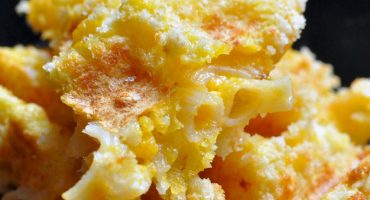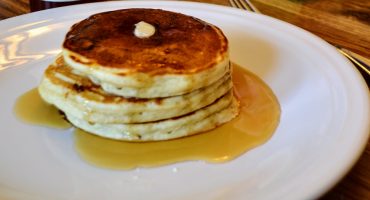
Fix The Fuck Up: It’s A French Thing

Editor’s Note: Fix the Fuck Up is an occasional series in which we try to look like we actually know what we’re doing, well, after we’ve already fucked up. Here’s the original massacre.
Eggs are evil.
Not misguided evil, like Darth Vader. Or megalomaniacal evil, like Dr. Moriarty. Or naturally evil, like cats. More like an oblivious, self-centered, lah-de-dah kind of evil; like Q. Eggs just do their own thing, often in spite of your best efforts to tame them. They collapse when you whip them into foams. They turn into waterlogged mush when you overcook them. They force you to blame your significant other for your own emission control problems. But the evilest thing eggs can do is fuck up both baking and cooking; sometimes both at the same time, as was the case with Allyson’s recent quiche quatastrophe.
The quiche is a queer duck in the pantheon of food because it is, in everything but name, a custard pie, which dredges up the baking heebie-jeebs for some of us because, as previously inferred, baking is evil, too. At the same time, most of the quiches we’re used to are savory jobs, served at overpriced brunches and chewed on cold as morning hangover cures. Since they have this reputation as a light entrée, we tend to forget that it’s essentially a baked good, and while we can play rough-as-guts with the various fillings that go into a “refrigerator pie,” the egg mixture that makes up the mortar has to follow an exacting science for optimal results.
The French call the quick-and-dirty mixture of eggs and dairy that makes up the body of a quiche a royale. The dairy can be any kind of cow milk, but the higher the fat content, the richer and creamier your quiche will be. Half-and-half or heavy cream work particularly well. Whatever you use, the proportions for a single quiche should be 1 cup of dairy mixed with 2 large eggs. This will make enough royale to fill an average pie shell, and is easily multiplied for additional quiches.
When combining the dairy and the eggs, a delicate violence is called for. Allyson used her electric mixer, which may have put a little too much hurt on the egg proteins. When raw eggs cook, their proteins, which normally look like little Slinkys, uncoil and get all tangled up with each other, which is what makes eggs scramble and quiches firm up. In their time in the mixer, the egg proteins probably got shredded to bits, which resulted in a structurally unstable final product. Instead, whisk your eggs, or even use just a fork. You want to just bring the two ingredients together and still leave the egg proteins more or less intact. A pinch of salt and maybe a bit of nutmeg, and your royale is good to go.
Any fillings you want in your quiche should be arranged in the empty pie shell before the royale gets added, including any cheese. High-moisture ingredients like spinach or mushrooms should be pre-cooked and squeezed of as much of their water as possible. Try not to pack it in too tightly, there needs to be some nooks and crannies for the royale to flow into so it can grab onto the fillings, kind of like the nuts in Nigella’s brownies (another previous fuck up from the ES crew).
Slowly pour in the royale and resist, with every fiber of your being, the urge to fill your crust to the brim. Eggs expand when they cook, so leaving a good half-inch of headroom will reduce the chances of overflow. It’s a good idea to put your quiche on a cookie sheet just in case.
Baking your quiche at 350° F for 45 minutes is the standard temperature and time, but start checking in on it at around 35 minutes. Just like a cake, using a wooden toothpick as a tester will give you some idea as to what’s going on underneath the surface. Poke it in near the center of the quiche, and if it comes out clean, it’s done. If it bleeds egg and milk, it needs a little more alone time. Once you evacuate your quiche, it needs to rest. Just like a good piece of meat, a hot quiche still has a lot of liquid running around inside of it, and letting it cool for at least 15 minutes will allow the interior to cool and set up properly, insuring a sliceable structure.
Quiches are a great way to use up leftovers, and therefore a culinary playground. Eggs are also still relatively cheap, and leftover quiche keeps pretty well wrapped in foil in the fridge. So even if the next refrigerator pie you make is a fuck-up, the one you make after that might not be. Practice may not always make perfect, but there’s enough of the spirit of cooking in making quiche to offset the evils of baking.




okay. wow. science.
so when you make scrambled eggs – do you first whisk them in a separate bowl or just stir them in a hot pan?
@gansie: Same thing for scrambled eggs; beat them a little separately, then add to the pan; that way the end result will be a more homogeneous mass. I’ve never tried scrambling eggs straight in the pan, but I would think that at least some of the proteins would cook and firm up immediately, leaving little chunks of fried white and yolk at the end.
How you cook them is another topic of debate; some say blast them at high heat so they’re done in like thirty seconds, others say low and slow. I always used to cook scrambled eggs on high and fried eggs on low; never did get the hang of omelets.
For other egg applications, like crepes, blending is actually encouraged, since crepes don’t rise hardly at all, cook in such a short time, and come out flat and smooth.
CATS are not evil. Watch it missy. 🙂 I’m only letting you get away with that because your picture in the US page is a cat
@Maids: They are when they whinge and claw and knock books off your shelves at 4 in the morning, wanting to be fed. Any other time of day they’re adorable.